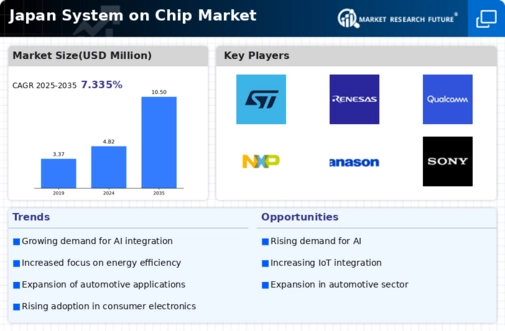Emergence of 5G Technology
The rollout of 5G technology in Japan is poised to revolutionize the system on-chip market. With the demand for high-speed connectivity and low latency, SoCs designed for 5G applications are becoming increasingly critical. As of November 2025, the 5G infrastructure is expected to expand significantly, leading to a projected growth of approximately 20% in the system on-chip market. This technology enables a wide range of applications, from enhanced mobile broadband to IoT connectivity, necessitating the development of specialized SoCs that can handle the increased data throughput. The competitive landscape is likely to intensify as companies strive to innovate and deliver cutting-edge solutions that meet the requirements of the 5G ecosystem.
Focus on Smart Manufacturing
Japan's manufacturing sector is increasingly adopting smart technologies, which is influencing the system on-chip market. The integration of IoT and AI in manufacturing processes is driving the need for advanced SoCs that can facilitate real-time data processing and analytics. As of November 2025, the smart manufacturing segment is projected to contribute significantly to the system on-chip market, with an expected growth rate of around 18% annually. This trend reflects a broader shift towards automation and efficiency in production, where SoCs play a crucial role in enabling connectivity and intelligence within manufacturing systems. The emphasis on Industry 4.0 is likely to further propel the demand for innovative SoC solutions.
Growth of Automotive Electronics
The automotive sector in Japan is undergoing a transformation, with a significant shift towards electric and autonomous vehicles. This transition is driving the demand for advanced system on-chip solutions that can support complex functionalities such as advanced driver-assistance systems (ADAS) and in-vehicle infotainment systems. By 2025, the automotive electronics market is anticipated to account for around 25% of the system on-chip market. The integration of SoCs in vehicles not only enhances performance but also contributes to improved safety and user experience. As automotive manufacturers increasingly rely on sophisticated electronics, the system on-chip market is poised for substantial growth, reflecting the industry's commitment to innovation and sustainability.
Rising Demand for Consumer Electronics
The system on-chip market in Japan experiences a notable surge in demand driven by the increasing consumption of consumer electronics. With the proliferation of smartphones, tablets, and smart home devices, manufacturers are seeking advanced SoC solutions to enhance performance and reduce power consumption. In 2025, the consumer electronics sector is projected to contribute approximately 30% of the overall revenue in the system on-chip market. This trend indicates a shift towards more integrated and efficient designs, as companies aim to meet consumer expectations for high-performance devices. The growing trend of IoT devices further amplifies this demand, as these products require sophisticated SoC architectures to manage connectivity and processing tasks effectively.
Advancements in Semiconductor Technology
Technological advancements in semiconductor manufacturing processes significantly impact the system on-chip market in Japan. Innovations such as 5nm and 3nm process nodes enable the production of smaller, more efficient chips that deliver enhanced performance. As of November 2025, the adoption of these cutting-edge technologies is expected to increase the market's growth rate by approximately 15% annually. This evolution allows for greater integration of functionalities within a single chip, reducing the overall size and cost of electronic devices. Furthermore, the development of new materials and techniques, such as FinFET and SOI technologies, is likely to enhance the performance and energy efficiency of SoCs, making them more appealing to manufacturers across various sectors.






















Leave a Comment